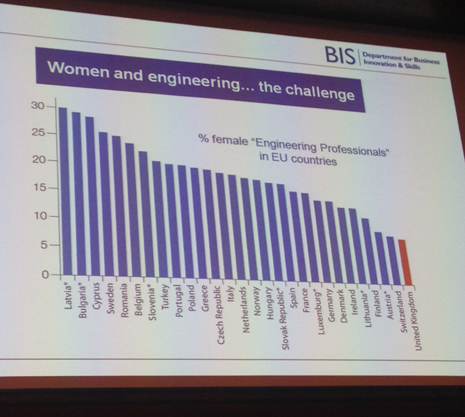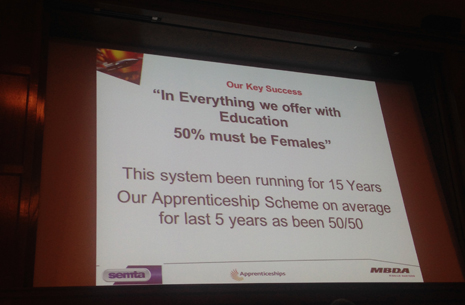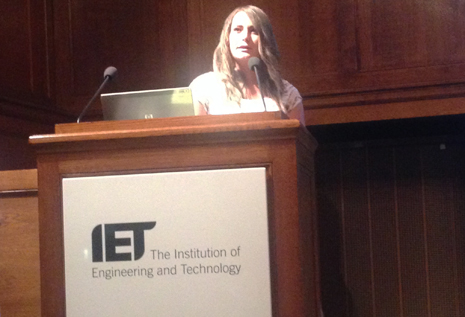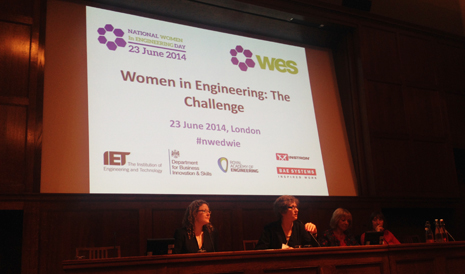
The NWED conference that took place at the iMechE headquarters in London
In case you missed it (unlikely if you’ve seen our twitter feed or facebook page today), it’s National Women in Engineering Day (NWED), with lots of events celebrating women in engineering all over the country.
At iMeche HQ in Westminster, the Womens Engineering Society (WES) hosted the NWED Conference.
I can’t explain how brilliant it was being at an engineering conference were 96 per cent of attendees were female. Having been a journalist in this industry for over 11 years, I’m used to seeing a sea of suits (the trouser variety) at industry events.
This highlights the whole crux of the issue and why the WES and other organisations are trying to up the profile of female engineers. There are just not enough of them.
As Jenny Willott, Minister for Women and Engineering in her keynote, said: “The statistic that horrifies me and spurs me on in this call to action is that in 2011 half of state financed co-ed schools failed to have a single girl study physics at A-level.”
Willott was just one of a raft of inspiring speakers at the conference. Kudos to WES for organising such an event and roping in such a high profile speaker line-up. Especially impressive as it is a charity supported by a volunteer network.
Speakers included such auspicious names as Ruth Spellman OBE, CEO of the Workers’ Educational Association; Dr Frances Saunders, president of the Institute of Physics, and Dr Nina Skorupska, CEO of the Renewable Energy Association. There were also representatives from various engineering organisations including RAEng, IET and WISE as well as women working in engineering themselves or teaching future engineers at colleges and universities.

Revealing how the UK is lagging behind its European counterparts
There were also a few token men, all pretty vocal about getting more females into engineering, including Professor John Perkins, chief scientific advisor at the Department for Business, Innovation & Skills (BIS), who spoke of the findings of his recent report: ‘Professor John Perkins’ Review of Engineering Skills’.
One of his slides (above) depicted how the UK is the worst in Europe in terms of the percentage of female engineering professionals with just 8 per cent.

MBDA’s philosophy on apprenticeships
One speaker that I particularly enjoyed was Gareth Humphreys, HR advisor for education at the engineering company MBDA Missile Systems in Lostock, Bolton, who heads the company’s apprenticeship scheme. His philosophy with the scheme is to have a 50 per cent split between male and female apprentices.
It has been hugely successful and Jade Aspinall, one of the apprentices currently in her third year, joined him on stage to talk about her experiences.

Jade Aspinall talking about her experiences as an apprentice at MBDA
Something that Aspinall mentioned that really struck me is that although we need to inspire young girls to pursue engineering as a career, we also have to educate parents in allowing their daughters to do so.
Aspinall’s parents did not want her to study engineering at university let alone pursue an engineering apprenticeship scheme, and might have never landed in her position if she didn’t ‘rebel’.
This was echoed by other speakers too, which I found interesting as I didn’t realise this was such a barrier for girls who wanted to become engineers.
In fact I was sitting next to a systems engineer from BAE Systems who said that she was an apprentice 25 years ago and the barriers that Jade spoke of, were exactly the same for her, highlighting that things need to change if the UK wants to fill the engineering jobs it needs to in the next 20 years.
Another theme that came up regularly was inspiring young people through role models and actually going into schools and talking to them.
During his talk Allan Cook, Chair of Atkins and Selex ES, described how he went into a school recently to speak to the children and before he started he asked them who would think about becoming an engineer when they grew up. Some of the boys raised their hands but not a single girl.
After his talk, however, having asked the same question, at least ten girls put their hands up. All it needs is one seed to take root…
There were other interesting themes, such as the issue of retention – females entering the profession, but then leaving to have a family and not retuning. I won’t go into this and others now – you’ll have to wait for DEVELOP3D’s July/August issue where I’ll be writing more on the event.
However, I want to conclude by saying that this event and having met so many lovely female engineers today, has made me feel more passionate than ever about getting girls interested in engineering and upping that dismal 8 per cent mentioned earlier.
I want to play my part and I’m hatching plans – whether it be organising female engineers to speak in schools or getting companies to support school trips. You can get involved too, for a start WES has some tips.






